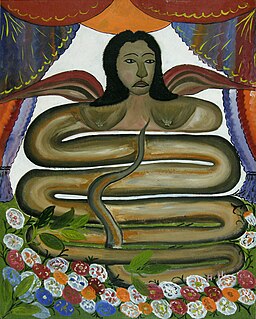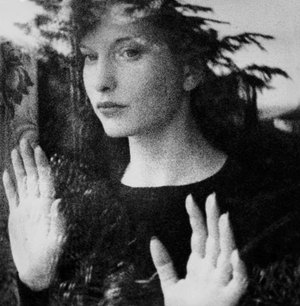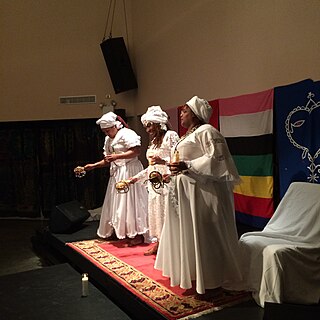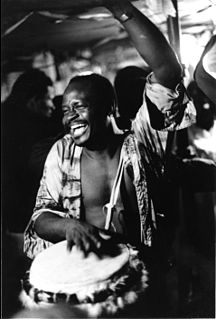Related Research Articles

Lwa, also called loa or loi, are spirits in the African diasporic religion of Haitian Vodou. They have also been incorporated into some revivalist forms of Louisiana Voodoo. Many of the lwa derive their identities in part from deities venerated in the traditional religions of West Africa, especially those of the Fon and Yoruba.

Vodun is a religion practiced by the Aja, Ewe, and Fon peoples of Benin, Togo, Ghana, and Nigeria.

Meshes of the Afternoon is a 1943 American short experimental film directed by and starring wife-and-husband team Maya Deren and Alexandr Hackenschmied. The film's narrative is circular and repeats several motifs, including a flower on a long driveway, a key falling, a door unlocked, a knife in a loaf of bread, a mysterious Grim Reaper–like cloaked figure with a mirror for a face, a phone off the hook and an ocean. Through creative editing, distinct camera angles, and slow motion, the surrealist film depicts a world in which it is more and more difficult to catch reality.

Damballa, also spelled Damballah, Dambala, Dambalah, among other variations, is one of the most important of all loa, spirits in Haitian Vodou, Louisiana Voodoo and other African diaspora religious traditions such as Obeah. He is traditionally portrayed as a great white serpent, originating in the city of Wedo in modern-day Benin. Damballa is said to be the Sky Father and the primordial creator of all life, or the first thing created by Gran Met. In those Vodou societies that view Damballa as the primordial creator, he created the cosmos by using his 7,000 coils to form the stars and the planets in the heavens and to shape the hills and valleys on earth. In others, being the first thing created by God, creation was undertaken through him. By shedding the serpent skin, Damballa created all the waters on the earth. As a serpent, he moves between land and water, generating life, and through the earth, uniting the land with the waters below. Damballa is usually syncretized with either Saint Patrick or Moses. He is counted among the Rada loa.

Papa Legba is a lwa in Haitian Vodou, who serves as the intermediary between the lwa and humanity. He stands at a spiritual crossroads and gives permission to speak with the spirits of Guineé, and is believed to speak all human languages. In Haiti, he is the great elocutioner. Legba facilitates communication, speech, and understanding. He is commonly associated with dogs. Papa Legba is invoked at the beginning of every ceremony. Papa Legba has his origins in the historic West African kingdom of Dahomey, located within present-day Benin.

Maya Deren was a Ukrainian-born American experimental filmmaker and important promoter of the avant-garde in the 1940s and 1950s. Deren was also a choreographer, dancer, film theorist, poet, lecturer, writer, and photographer.

Nana Buluku, also known as Nana Buruku, Nana Buku or Nanan-bouclou, is the female supreme being in the West African traditional religion of the Fon people and the Ewe people (Togo). She is the most influential deity in West African theology, one shared by many ethnic groups other than the Fon people, albeit with variations. For example, she is called the Nana Bukuu among the Yoruba people and the Olisabuluwa among Igbo people but described differently, with some actively worshiping her while some do not worship her and worship the gods originating from her.
Haitian Vodou is a syncretic mixture of Roman Catholic rituals developed during the French colonial period, based on traditional African beliefs, with roots in Dahomey, Kongo and Yoruba traditions, and folkloric influence from the indigenous Taino peoples of Haiti. The Loa, or spirits with whom Vodouisants work and practice, are not gods but servants of the Supreme Creator Bondye. In keeping with the French-Catholic influence of the faith, vodousaints are for the most part monotheists, believing that the Loa are great and powerful forces in the world with whom humans interact and vice versa, resulting in a symbiotic relationship intended to bring both humans and the Loa back to Bondye. "Vodou is a religious practice, a faith that points toward an intimate knowledge of God, and offers its practitioners a means to come into communion with the Divine, through an ever evolving paradigm of dance, song and prayers."

Oungan is the term for a male priest in Haitian Vodou. The term is derived from Gbe languages [[Fon, Ewe, Adja, Phla, Gen ,Maxi and Gun). The word hounnongan means chief priest. ‘'Hounnongan or oungans are also known as makandals.

A manbo is a priestess in the Haitian Vodou religion. Haitian Vodou's conceptions of priesthood stem from the religious traditions of enslaved people from Dahomey, in what is today Benin. For instance, the term manbo derives from the Fon word nanbo. Like their West African counterparts, Haitian manbos are female leaders in Vodou temples who perform healing work and guide others during complex rituals. This form of female leadership is prevalent in urban centers such as Port-au-Prince. Typically, there is no hierarchy among manbos and oungans. These priestesses and priests serve as the heads of autonomous religious groups and exert their authority over the devotees or spiritual servants in their hounfo (temples).
The Rada are a family of lwa spirits in the religion of Haitian Vodou. They are regarded as being sweet-tempered and "cool", in this contrasting with the Petro lwa, which are regarded as volatile and "hot".

Haitian Vodou is an African diasporic religion that developed in Haiti between the 16th and 19th centuries. It arose through a process of syncretism between several traditional religions of West and Central Africa and the Roman Catholic form of Christianity. There is no central authority in control of the religion and much diversity exists among practitioners, who are known as Vodouists, Vodouisants, or Serviteurs.

Teiji Ito was a Japanese composer and performer. He is best known for his scores for the avant-garde films by Maya Deren.
Vodou drumming and associated ceremonies are folk ritual faith system of henotheistic religion of Haitian Vodou originated and inextricable part of Haitian culture.

Filmworks X: In the Mirror of Maya Deren features a score for film by John Zorn. The album was released on Zorn's own label, Tzadik Records, in 2001 and contains music that Zorn wrote and recorded for the documentary film In the Mirror of Maya Deren on the life and work of Maya Deren directed by Martina Kudlácek.
Marie Thérèse Alourdes Macena Champagne Lovinski (1933–2020), also known by the name Mama Lola, was a Haitian-born manbo (priestess) in the African diasporic religion of Haitian Vodou. She had lived in the United States since 1963.

Frisner Augustin was a major performer and composer of Haitian Vodou drumming, and the first and only citizen of Haiti to win a National Heritage Fellowship from the National Endowment for the Arts in the United States, where he resided for forty years.

Ritual in Transfigured Time (1946) is a short, silent experimental film directed by Maya Deren. Like Deren's previous work, A Study in Choreography for Camera (1945), she explores the use of dance on film through the lens of commentary of societal norms, metamorphosis, and anthropomorphism. The film is notable for its disjointed storytelling and use of slow motion, freeze framing, and unique blend of stage dance and film.
The potomitan is an essential structural feature of the hounfour (temple) in Haitian vodou. Occupying the central position in the peristyle, the potomitan takes the form of a decorated wooden post by means of which, it is believed, the loa descend to earth to inhabit, for a time, the bodies of the faithful through spirit possession.

Voodoo in popular culture encompasses various representations of practices associated with different forms of voodoo, including Haitian Vodou and Louisiana Voodoo, and other elements attributed to African diaspora religions, with such representations often deviating substantially from any actual voodoo practices or beliefs. Tropes regarding voodoo appear most often in supernatural fantasy or horror films, with common themes including the activity of witch doctors, the summoning or control of dark spirits, use of voodoo dolls to inflict pain on people remotely, and the creation of zombies.
References
- Lois E. Wilcken, Review of Divine Horsemen: The Living Gods of Haiti
- Maya Deren, Divine Horsemen: The Voodoo Gods of Haiti (New York: Vanguard Press, 1953) original edition of Deren's book
- Teiji Ito and Cheryl Ito, Ethnomusicology , Vol. 30, No. 2. (Spring -Summer 1986), pp. 313–318.
- Notes on Deren's Haitian Footage, Maya Deren Forum.
- "Maya Deren's Ethnographic Representation of Ritual and Myth in Haiti", Moira Sullivan, in Maya Deren and the American Avant-Garde, Bill Nichols, editor, 2001.